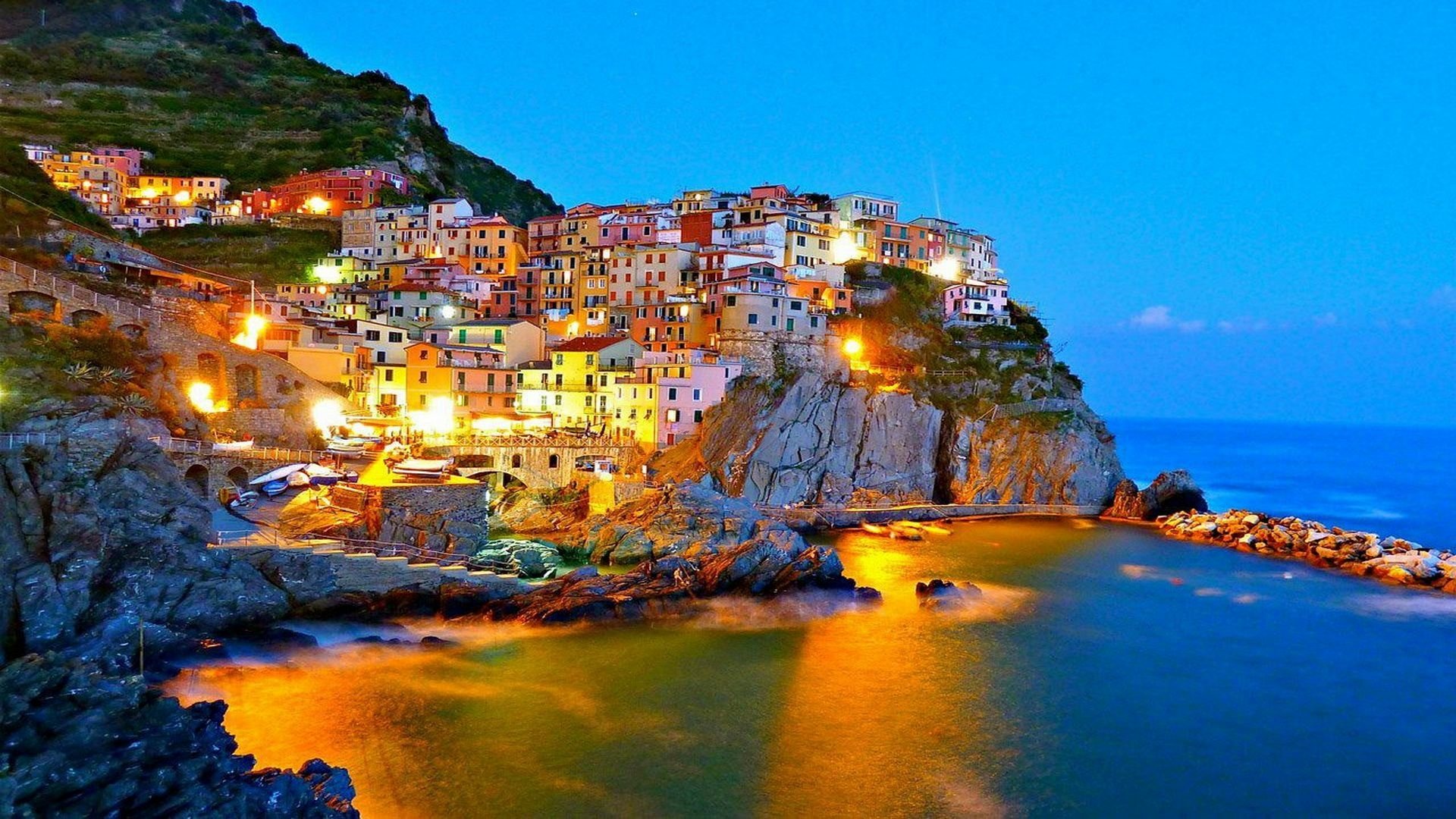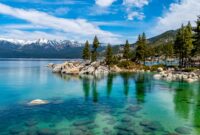Good places to go on vacation are a topic of endless fascination, sparking dreams of sun-drenched beaches, bustling cityscapes, or thrilling adventures. This exploration delves into diverse destinations, budget considerations, and various travel styles, equipping you with the knowledge to plan your ideal getaway. We’ll examine popular and lesser-known spots, offering insights into maximizing your vacation experience while considering responsible and sustainable travel practices.
From meticulous budget planning to choosing the perfect type of vacation experience—be it relaxation, adventure, or cultural immersion—we provide a comprehensive guide. We’ll cover everything from securing the best flight and accommodation deals to capturing memorable travel photos and crafting engaging travel stories. Ultimately, the goal is to empower you to plan a fulfilling and unforgettable vacation.
Popular Vacation Destinations
Choosing the perfect vacation destination can be overwhelming, given the sheer number of options available worldwide. This section will explore some popular and lesser-known destinations, categorizing them by continent and highlighting their unique offerings to help you plan your next adventure. We will also examine the advantages and disadvantages of different vacation types.
Popular Vacation Destinations by Continent
The following table lists ten popular vacation destinations, categorized by continent, along with brief descriptions and typical activities. These destinations consistently rank highly in travel surveys and offer a diverse range of experiences.
| Destination | Continent | Brief Description | Typical Activities |
|---|---|---|---|
| Paris | Europe | A romantic city renowned for its art, history, and cuisine. | Visiting museums (Louvre, Musée d’Orsay), exploring historical landmarks (Eiffel Tower, Notre Dame Cathedral), enjoying Parisian cafes and restaurants. |
| Maui, Hawaii | North America | A Hawaiian island offering stunning beaches, lush landscapes, and volcanic scenery. | Swimming, sunbathing, surfing, hiking, whale watching (seasonal). |
| Rome | Europe | The historical heart of Italy, filled with ancient ruins, stunning architecture, and delicious food. | Visiting the Colosseum, Roman Forum, Vatican City, enjoying pasta and gelato. |
| Kyoto | Asia | A city in Japan known for its traditional temples, gardens, and geishas. | Visiting temples and shrines (Kinkaku-ji, Fushimi Inari-taisha), exploring traditional gardens, attending tea ceremonies. |
| Machu Picchu | South America | An ancient Inca citadel located high in the Andes Mountains of Peru. | Hiking the Inca Trail, exploring the ruins, experiencing the breathtaking mountain scenery. |
| Santorini | Europe | A Greek island famous for its whitewashed villages, stunning sunsets, and volcanic landscapes. | Exploring the villages (Oia, Fira), swimming, sunbathing, enjoying the caldera views. |
| Cape Town | Africa | A city in South Africa known for its stunning natural beauty, vibrant culture, and diverse wildlife. | Visiting Table Mountain, exploring the Cape Peninsula, wine tasting in Stellenbosch, wildlife safaris. |
| Sydney | Oceania | A vibrant coastal city in Australia known for its iconic Opera House and Harbour Bridge. | Visiting the Opera House and Harbour Bridge, exploring Bondi Beach, enjoying the city’s diverse culinary scene. |
| Bora Bora | Oceania | A French Polynesian island offering luxurious overwater bungalows and pristine beaches. | Snorkelling, diving, relaxing on the beach, enjoying water sports. |
| Buenos Aires | South America | A vibrant city in Argentina known for its tango, architecture, and rich culture. | Exploring the city’s neighbourhoods (San Telmo, Palermo), enjoying tango shows, visiting museums and historical sites. |
Lesser-Known Vacation Destinations
Beyond the well-trodden paths, many lesser-known destinations offer unique and unforgettable experiences. These locations provide a chance to escape the crowds and discover something truly special.
- Matera, Italy: A city in southern Italy with ancient cave dwellings, offering a unique glimpse into history and culture.
- Chefchaouen, Morocco: A picturesque town known for its blue-washed buildings and stunning mountain backdrop.
- Salar de Uyuni, Bolivia: The world’s largest salt flat, offering breathtaking landscapes and surreal photo opportunities.
- Isle of Skye, Scotland: A rugged and dramatic island with stunning landscapes, including mountains, lochs, and dramatic coastlines.
- Jiufen, Taiwan: A charming mountain town with tea houses and stunning views of the coastline.
Advantages and Disadvantages of Different Vacation Types
The ideal vacation depends on individual preferences. Each type of vacation offers unique benefits and drawbacks.
Beach vacations offer relaxation and sunshine, but can be crowded and expensive during peak season. City vacations provide cultural immersion and diverse activities, but can be fast-paced and overwhelming. Adventure vacations offer thrilling experiences, but may involve physical challenges and risks. Careful consideration of these factors is crucial for a successful trip.
Budget Considerations for Vacations
Planning a vacation requires careful consideration of various factors, and budgeting is paramount to ensuring a smooth and enjoyable trip. A well-structured budget helps prevent unexpected financial strain and allows for a more relaxed and fulfilling experience. This section will explore practical strategies for creating and managing a vacation budget.
Sample Vacation Budget
A well-defined budget is essential for successful vacation planning. The following table illustrates a sample budget for a week-long vacation for two people. Remember that these are estimates, and actual costs can vary depending on your choices and destination.
| Category | Amount |
|---|---|
| Flights (round-trip for two) | $1000 |
| Accommodation (7 nights) | $700 |
| Activities and Entertainment | $500 |
| Food and Drinks | $400 |
| Transportation (local) | $100 |
| Souvenirs and Miscellaneous | $100 |
| Total | $2800 |
Peak Season vs. Off-Season Travel Costs
The time of year significantly impacts vacation costs. Peak season, typically during holidays and summer months, sees higher prices for flights and accommodation. Off-season travel offers significant savings. The following table compares costs for three destinations:
| Destination | Peak Season (Flights & Accommodation per person) | Off-Season (Flights & Accommodation per person) |
|---|---|---|
| Paris, France | $1500 | $900 |
| Maui, Hawaii | $2000 | $1200 |
| Mexico City, Mexico | $800 | $500 |
These figures are approximate and can vary depending on the specific dates and booking platforms used. Consider that the savings in off-season travel can be substantial.
Strategies for Saving Money on Flights and Accommodation
Several strategies can help reduce travel expenses. Booking flights and accommodation in advance often secures better prices, particularly during peak seasons. Utilizing flight comparison websites allows for price comparisons across different airlines and booking platforms. Consider alternative accommodation options like Airbnb or hostels for potentially lower costs compared to hotels. Flexibility with travel dates can also lead to savings, as prices often fluctuate throughout the week and month. Lastly, taking advantage of travel deals and loyalty programs can yield significant cost reductions.
Types of Vacation Experiences
Choosing the right type of vacation is crucial for a memorable and enjoyable trip. The ideal vacation depends heavily on individual preferences, travel style, and budget. This section categorizes different vacation experiences to help you find the perfect fit.
| Vacation Type | Description | Key Activities & Attractions |
|---|---|---|
| Adventure Travel | Adventure travel focuses on physically challenging activities and exploring remote or unusual destinations. It often involves a degree of risk and requires a higher level of physical fitness. | Hiking, trekking, white-water rafting, rock climbing, zip-lining, wildlife safaris, exploring caves, visiting national parks. |
| Relaxation Vacations | Relaxation vacations prioritize rest, rejuvenation, and stress reduction. They typically involve minimal physical exertion and focus on comfort and pampering. | Spa treatments, lounging on beaches, swimming in calm waters, enjoying leisurely meals, reading books, practicing yoga, meditation retreats. |
| Cultural Immersion | Cultural immersion vacations emphasize learning about and experiencing a new culture firsthand. This often involves interacting with locals, learning about local traditions, and exploring historical sites. | Visiting museums, historical sites, attending cultural events, taking cooking classes, learning a new language, interacting with local communities, exploring local markets. |
| Family-Friendly Vacations | Family-friendly vacations cater to the needs of families with children of various ages. They typically involve a mix of activities suitable for all ages and prioritize safety and convenience. | Theme parks, water parks, kid-friendly beaches, zoos, aquariums, family-friendly resorts with children’s clubs, interactive museums. |
Travel Styles and Their Characteristics
Different travel styles significantly impact the overall vacation experience. Each style presents unique advantages and disadvantages that should be carefully considered.
Backpacking
Backpacking is characterized by budget-conscious travel, often involving long-distance journeys and independent exploration. Backpackers typically stay in hostels, guesthouses, or campgrounds to minimize costs. Backpacking offers unparalleled freedom and the opportunity to immerse oneself in local cultures. However, it can be physically demanding and requires meticulous planning and adaptability. For example, a backpacking trip through Southeast Asia might involve navigating crowded buses, finding affordable street food, and adjusting to different cultural norms.
Luxury Travel
Luxury travel prioritizes comfort, exclusivity, and personalized service. It often involves staying in high-end hotels, indulging in fine dining, and enjoying bespoke experiences. Luxury travel offers an unparalleled level of comfort and convenience, but it comes at a significantly higher cost. A luxury cruise to the Caribbean, for instance, provides access to lavish accommodations, gourmet meals, and various onboard amenities, but it may lack the authentic cultural immersion found in other travel styles.
All-Inclusive Resorts
All-inclusive resorts offer a convenient and hassle-free vacation experience. The price includes accommodation, meals, drinks, and often activities and entertainment. This eliminates the need for budgeting for individual expenses, simplifying the travel process. However, all-inclusive resorts can sometimes lack authenticity and may not offer the same level of cultural immersion as other travel styles. A stay at an all-inclusive resort in Mexico, for example, may provide easy access to the beach and amenities but may not offer the same opportunities to interact with local culture as exploring smaller towns independently.
Planning and Booking a Vacation
Planning a vacation can seem daunting, but breaking it down into manageable steps makes the process much smoother. From choosing your dream destination to securing your flights and accommodation, careful planning ensures a stress-free and enjoyable trip. This section provides a comprehensive guide to help you navigate each stage of the vacation booking process.
Step-by-Step Vacation Planning Guide
A well-structured approach is key to successful vacation planning. Following these steps will help you organize your thoughts and efficiently book your trip.
- Define your travel goals and preferences: Determine the type of vacation you desire (relaxing beach getaway, adventurous hiking trip, cultural city exploration, etc.), your preferred travel style (luxury, budget-friendly, etc.), and your desired travel dates and duration.
- Research and select your destination: Based on your preferences, research potential destinations. Consider factors such as climate, activities, cost of living, and visa requirements. Websites like TripAdvisor, Lonely Planet, and travel blogs can be invaluable resources.
- Set a budget: Determine how much you’re willing to spend on your entire trip, including flights, accommodation, activities, food, and transportation. Tracking your spending throughout the planning process helps avoid overspending.
- Book flights: Use flight comparison websites (e.g., Google Flights, Skyscanner, Kayak) to find the best deals. Be flexible with your travel dates if possible, as prices often vary significantly depending on the day of the week and time of year. Consider booking flights in advance, especially during peak season, to secure better prices.
- Book accommodation: Once your flights are booked, reserve your accommodation. Websites like Booking.com, Expedia, and Airbnb offer a wide range of options to suit different budgets and preferences. Read reviews carefully before making a reservation.
- Plan your itinerary: Research activities and attractions at your destination and create a tentative itinerary. This helps you maximize your time and ensure you don’t miss out on anything you want to see or do. Remember to factor in travel time between locations.
- Purchase travel insurance: Travel insurance is crucial to protect yourself against unforeseen circumstances such as flight cancellations, medical emergencies, or lost luggage. Choose a policy that covers your specific needs and travel plans.
- Confirm bookings and make necessary arrangements: Double-check all your bookings (flights, accommodation, activities) and make any necessary arrangements for transportation (airport transfers, car rentals) or visas.
Finding the Best Deals on Flights and Hotels
Securing affordable travel arrangements is a key aspect of vacation planning. Employing strategic booking techniques can significantly reduce costs.
To find the best deals on flights, consider booking during off-peak seasons, being flexible with your travel dates, using flight comparison websites, and signing up for airline newsletters to receive alerts about sales and promotions. For hotels, consider booking in advance, looking for deals and discounts on hotel booking websites, and considering alternative accommodation options such as hostels or guesthouses for budget-friendly stays. Utilizing reward programs and loyalty points can also offer significant savings.
The Importance of Travel Insurance and its Coverage
Travel insurance offers vital protection against unexpected events during your trip. It mitigates financial risks and provides peace of mind.
Travel insurance policies typically cover a range of scenarios, including trip cancellations or interruptions due to unforeseen circumstances (e.g., illness, natural disasters), medical emergencies and expenses, lost or stolen luggage, and personal liability. The specific coverage varies depending on the policy, so it’s essential to carefully review the policy details before purchasing. For example, some policies may offer coverage for pre-existing medical conditions, while others may not. Consider the level of coverage needed based on your destination, activities, and personal circumstances. A comprehensive policy provides extensive protection, ensuring a worry-free vacation.
Sustainable and Responsible Travel
Sustainable tourism is increasingly important as the global travel industry expands. It aims to minimize the negative impacts of tourism on the environment and local communities while maximizing the positive contributions. This involves conscious choices by travelers and responsible practices by tourism operators.
Eco-friendly travel practices and destinations are gaining popularity as awareness of environmental issues grows. The impact of tourism on local communities and environments can be significant, both positive and negative, highlighting the need for mindful travel. By understanding these impacts, we can work towards a more responsible and sustainable approach to travel.
Eco-Friendly Travel Practices
Adopting eco-friendly travel practices significantly reduces your carbon footprint and supports local communities. These practices contribute to the preservation of natural resources and cultural heritage for future generations.
- Reduce your carbon emissions: Choose direct flights whenever possible, consider train travel for shorter distances, and offset unavoidable carbon emissions through reputable carbon offsetting programs.
- Minimize waste: Carry a reusable water bottle, coffee cup, and shopping bag. Avoid single-use plastics and dispose of waste responsibly.
- Support local businesses: Choose locally owned accommodations, restaurants, and tour operators. This helps to distribute tourism revenue more equitably within the community.
- Respect wildlife and natural environments: Avoid disturbing wildlife habitats, follow designated trails, and refrain from purchasing souvenirs made from endangered species.
- Learn about the local culture and customs: Respect local traditions and customs. Dress modestly when visiting religious sites and be mindful of local sensitivities.
Examples of Eco-Friendly Destinations
Several destinations are actively promoting sustainable tourism practices. These locations often prioritize environmental protection and community involvement.
- Costa Rica: Known for its commitment to ecotourism, Costa Rica boasts numerous national parks and reserves dedicated to conservation. Many eco-lodges and sustainable tourism operators offer unique experiences while minimizing environmental impact. Imagine staying in a lodge built with sustainable materials, surrounded by lush rainforest, and participating in a guided nature walk led by a local expert.
- Bhutan: Bhutan’s Gross National Happiness index prioritizes environmental sustainability and cultural preservation. Tourism here is carefully managed to minimize environmental impact and maximize benefits for local communities. Picture yourself trekking through stunning Himalayan landscapes, visiting ancient monasteries, and experiencing the unique Bhutanese culture.
- New Zealand: New Zealand has a strong focus on conservation and sustainable practices. Many tourism operators adhere to strict environmental guidelines, ensuring minimal impact on the country’s stunning natural landscapes. Envision yourself kayaking through pristine fjords, hiking through breathtaking national parks, and experiencing the Maori culture in a respectful and authentic way.
The Impact of Tourism on Local Communities and Environments
Tourism’s impact on local communities and environments is multifaceted. While it can bring economic benefits, it can also lead to environmental degradation and social disruption if not managed responsibly.
Tourism can contribute to economic growth by creating jobs and generating revenue. However, uncontrolled tourism can lead to environmental damage through habitat destruction, pollution, and resource depletion. For example, increased traffic congestion in popular tourist areas can lead to air pollution and damage to infrastructure. Overcrowding in natural areas can disrupt wildlife habitats and lead to ecological imbalances. Conversely, responsible tourism can empower local communities, preserving cultural heritage and fostering environmental stewardship.
Sustainable Travel Itinerary: A Sample
A sustainable travel itinerary prioritizes minimizing environmental impact and maximizing positive contributions to the local community. This approach involves careful planning and consideration of various aspects of travel.
A sample itinerary for a week-long trip to Costa Rica could include:
- Accommodation: Stay in an eco-lodge certified by a reputable organization, ensuring sustainable practices are implemented.
- Transportation: Utilize public transportation or rent a hybrid or electric vehicle whenever possible.
- Activities: Participate in guided nature walks or tours led by local guides, ensuring that your activities support local businesses and respect the environment.
- Food: Eat at locally owned restaurants, prioritizing locally sourced ingredients and reducing food miles.
- Souvenirs: Purchase souvenirs made by local artisans, supporting local crafts and businesses.
Travel Photography and Storytelling
Capturing the essence of a travel experience goes beyond simply visiting a place; it involves preserving the memories and sharing the journey with others. This involves both compelling photography and engaging storytelling, which when combined, create a lasting impact. Effective travel photography and storytelling can inspire others, evoke emotions, and help potential travelers plan their own adventures.
Travel photography and storytelling are intrinsically linked; strong visuals enhance narratives, while compelling stories provide context and meaning to photographs. Mastering both aspects elevates the overall travel experience, transforming fleeting moments into enduring memories.
Tips for Taking Captivating Travel Photos
High-quality travel photography relies on understanding both technical aspects and compositional elements. By focusing on these key areas, you can significantly improve the impact of your travel photos.
- Mastering Light: The golden hour (sunrise and sunset) offers the most flattering light, casting long shadows and creating a warm, inviting atmosphere. Avoid harsh midday sun, which can wash out colors and create harsh shadows.
- Rule of Thirds: Instead of centering your subject, position it along imaginary lines that divide the frame into thirds both horizontally and vertically. This creates a more visually appealing and balanced composition.
- Leading Lines: Utilize natural lines like roads, rivers, or fences to draw the viewer’s eye into the image and towards your main subject. This creates depth and visual interest.
- Experiment with Perspectives: Don’t just shoot from eye level. Get down low, climb up high, or shoot from unusual angles to create unique and captivating perspectives.
- Storytelling Through Details: Capture small details that tell a story about the place – a worn-out sign, a vibrant flower, or a local’s hand-crafted item. These details add depth and authenticity to your photos.
Advice on Writing Engaging Travel Stories or Blog Posts
Crafting compelling travel narratives requires more than just recounting your itinerary; it involves evoking emotions, creating a sense of place, and engaging the reader. By incorporating these elements, you can transform your travel experiences into captivating stories.
- Show, Don’t Tell: Instead of simply stating “The food was delicious,” describe the aromas, textures, and tastes in vivid detail. Engage the reader’s senses.
- Focus on a Central Theme: What was the most memorable aspect of your trip? Develop your story around this theme, allowing other experiences to support and enrich it.
- Incorporate Personal Reflections: Share your feelings, thoughts, and reactions to the places you visited. This adds authenticity and makes your story more relatable.
- Use Strong Verbs and Vivid Adjectives: Choose words that paint a picture and bring your story to life. Avoid clichés and generic descriptions.
- Edit and Refine: Once you’ve written your draft, take time to edit and refine your work. Ensure clarity, flow, and impactful storytelling.
Using Descriptive Language to Evoke Atmosphere and Feeling
Descriptive language is crucial for transporting your readers to the places you’ve visited. By using sensory details and evocative imagery, you can create a vivid and immersive experience for your audience.
The air hung heavy with the scent of jasmine and salt, a warm breeze whispering secrets through the swaying palm trees. The sun dipped below the horizon, painting the sky in fiery hues of orange and crimson, casting long shadows across the white sand beach.
This example uses sensory details (smell, touch, sight) to create a vivid picture of a tropical beach at sunset. By employing such descriptive language throughout your writing, you can effectively transport your readers and make your travel stories come alive.
Final Summary
Planning the perfect vacation involves careful consideration of numerous factors, from budget and destination to travel style and sustainability. By understanding the various aspects explored in this guide, you can confidently navigate the planning process, creating a memorable and enriching experience. Whether you seek relaxation on a tropical beach, adventure in the mountains, or cultural immersion in a vibrant city, remember that responsible and sustainable travel practices can enhance your trip while protecting the environment and supporting local communities. So, start dreaming, plan meticulously, and embark on your unforgettable adventure!




